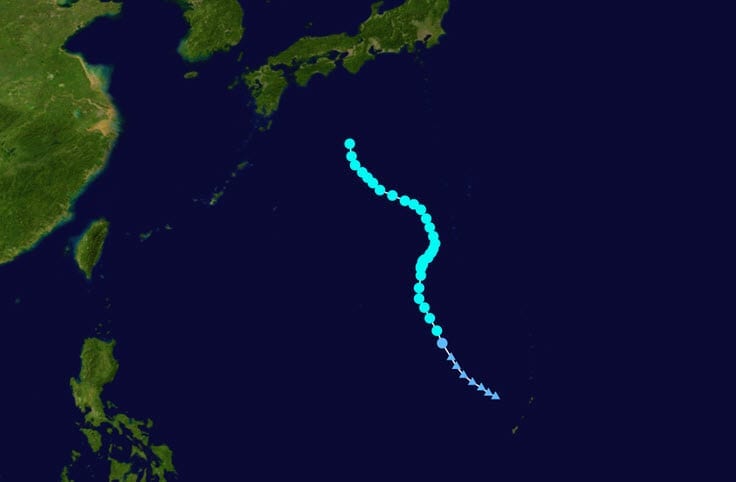 BOSTON, Sept. 2, 2011 – According to catastrophe modeling firm AIR Worldwide, Typhoon Talas formed on August 25 as the Japan Meteorological Agency’s (JMA) 12th named storm of the 2011 Northwest Pacific typhoon season. The typhoon is located south of Osaka, Japan, moving 12 km/h in a north-northwest direction. Talas is a large storm, with tropical storm force winds extending up to 650 km from its center. Maximum 10-min sustained wind speeds are 120 km/h (with gusts up to 175 km/h), making it a weak Category 1 hurricane on the Saffir-Simpson scale.
BOSTON, Sept. 2, 2011 – According to catastrophe modeling firm AIR Worldwide, Typhoon Talas formed on August 25 as the Japan Meteorological Agency’s (JMA) 12th named storm of the 2011 Northwest Pacific typhoon season. The typhoon is located south of Osaka, Japan, moving 12 km/h in a north-northwest direction. Talas is a large storm, with tropical storm force winds extending up to 650 km from its center. Maximum 10-min sustained wind speeds are 120 km/h (with gusts up to 175 km/h), making it a weak Category 1 hurricane on the Saffir-Simpson scale.
“The storm is expected to maintain its present slow north-northwest movement toward the south coast of Japan,” said Dr. Peter Sousounis, principal scientist at AIR Worldwide. “Little change in intensity is currently forecast prior to landfall, which is expected to occur late Friday or early Saturday, local time. Talas is currently forecast to make landfall on Shikoku Island and then cross into Honshu Island during the day on Saturday. Because of the storm’s large size, the duration of damaging winds will likely be more than 24 hours in many coastal locations.”
“Talas is then expected to exit into Sea of Japan, where it will pick up speed as it interacts with an eastward moving trough and recurve towards the northeast as it crests the subtropical ridge, currently located east of Japan. A second landfall is possible on Sunday anywhere from the Primorsky Krai region of far eastern Russia to west coast of Hokkaido Island.”
As Talas approaches landfall, Japan’s mountainous coast will enhance precipitation on the north and east sides of the storm, creating flood and landslide hazards. This occurs because as the counterclockwise flow of air comes onshore, it is forced over the mountainous terrain, cooling in its ascent and forming clouds and precipitation. According to current measurements from Tropical Rainfall Measuring Mission satellites, total accumulated precipitation of 200-300 mm is likely in coastal
locations, while higher amounts are expected in the mountains.
Dr. Sousounis continued, “Talas’s outer rainbands are already beginning to impact coastal Shikoku and Kinki regions with precipitation rates of less than 10 mm/hr along the coast to as high as 25 mm/hr at higher elevations. Associated with these rain bands are coastal 10-minute sustained winds of up to 40 km/hr. Currently, over a dozen prefectures near the landfall location and along the east side of the
forecast track have been placed on alert for ground-loosening precipitation.”
Following devastating inland flood damage from Typhoon Kathleen in 1947 and coastal storm surge damage from Typhoon Vera in 1959, the government of Japan embarked on a massive effort to protect the country against future flood losses. Today, large-scale flood control structures (LFCS) in Japan include dams, embankments, underground cisterns and super levees. Thus, flood risk in Japan depends on both the accumulated runoff (which is a function of precipitation level, topography, and soil conditions) and flood defenses, which vary by region.
According to AIR, Japan has strict and well-enforced construction codes, and modern structures are expected to withstand Talas’ forecast wind speeds with minimal structural damage. More than 50% of residential structures and 95% of commercial and industrial structures are insured for wind damage in Japan. The primary concern from Typhoon Talas is flood damage, which is not automatically included in wind policies. In typical flood policies in Japan, a specified payout is made only when the actual damage falls within a specified range.
Much like for wind, the vulnerability of buildings to flood damage varies by construction type. For a given flood depth, a residential wood-frame building is
expected to sustain more damage than a residential masonry building. Concrete construction is less vulnerable to flood than steel (which may experience surface corrosion and rust-induced expansion) or masonry structures (whose weak connections between building elements makes it permeable to water). Concrete buildings have a strong frame structure, but may suffer from cracking and rebar expansion. Commercial and apartment buildings usually have stronger foundations than residential buildings, and are thus better able to resist flood loads.
Furthermore, flood vulnerability varies by building height. Because damage is usually limited to the lower stories of a building, high-rise buildings will experience a lower damage ratio-the ratio of the repair cost and the total replacement value of the building-than low-rise buildings because a smaller proportion of the building is affected.
AIR is monitoring Typhoon Talas closely and will provide updates as warranted by events.
